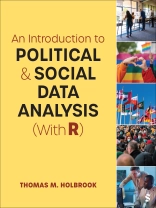An Introduction to Political and Social Data Analysis (With R) provides students with an accessible overview of practical data analysis while also providing a gentle introduction to R. By starting with statistics first and using just enough R code to generate results, this text helps students focus on learning how to do data analysis while slowly gaining confidence in using R as they progress through the material. This book is structured around learning by doing. Students can follow along in each chapter by reading about statistics and their applications in R, and then running the R code on their own as they work through contemporary political science and social science examples. Author Thomas M. Holbrook patiently explains each step in in the process, avoiding overly complicated jargon and commands. Exercises at the end of chapters feature both conceptual and calculation-based questions so students can check their understanding of data analysis and practice using R. At the end of the semester, students can confidently add skills in data analysis with R to their resumes.
Tabla de materias
Chapter 1: Introduction to Research and Data
Political and Social Data Analysis
Data Analysis or Statistics?
Uses of Data Analysis
The Research Process
Other Data-Related Issues
Causal Language
Next Steps
Exercises
Chapter 2: Using R to Do Data Analysis
Accessing R
Opening RStudio
Understanding Where R (or Any Program) Fits In
Time to Use R
Some R Terminology
Managing Files and Output
Next Steps
Exercises
Chapter 3: Frequencies and Basic Graphs
Get Ready
Introduction
Frequencies
Graphing Outcomes
Next Steps
Exercises
Chapter 4: Data Preparation
Get Ready
Introduction
Data Transformations
Collapsing and Reordering Categories
Combining Variables
Save Your Changes
Next Steps
Exercises
Chapter 5: Measures of Central Tendency
Get Ready
Central Tendency
Mode
Median
The Mean
Mean, Median, and the Distribution of Variables
Skewness Statistic
Adding Legends to Graphs
Next Steps
Exercises
Chapter 6: Measures of Dispersion
Get Ready
Introduction
Measures of Spread
Dispersion Around the Mean
Dichotomous Variables
Dispersion in Categorical Variables?
The Standard Deviation and the Normal Curve
Calculating Area Under a Normal Curve
One Last Thing
Next Steps
Exercises
Chapter 7: Probability
Get Ready
Probability
Theoretical Probabilities
Empirical Probabilities
The Normal Curve and Probability
Next Steps
Exercises
Chapter 8: Sampling and Inference
Get Ready
Statistics and Parameters
Sampling Error
Sampling Distributions
Proportions
Confidence Intervals
Next Steps
Exercises
Chapter 9: Hypothesis Testing
Get Ready
The Logic of Hypothesis Testing
Direct Hypothesis Tests
Proportions
T-Distribution
Types of Error
t-test in R
Next Steps
Exercises
Chapter 10: Hypothesis Testing with Two Groups
Get Ready
Testing Hypotheses About Two Means
Hypothesis Testing With Two Means
Difference in Proportions
Plotting Mean Differences
What’s Next?
Exercises
Chapter 11: Hypothesis Testing With Multiple Groups (ANOVA)
Get Ready
Internet Access as an Indicator of Development
The Relationship Between Wealth and Internet Access
Analysis of Variance
Anova in R
Effect Size
Connecting the t-score and F-ratio
Next Steps
Exercises
Chapter 12: Hypothesis Testing with Non-Numeric Variables (Crosstabs)
Get Ready
Crosstabs
Sampling Error
Hypothesis Testing With Crosstabs (Chi-square)
Get Ready
Directional Patterns in Crosstabs
Limitations of Chi-square
Next Steps
Exercises
Chapter 13: Measures of Association
Get Ready
Going Beyond Chi-squared
Measures of Association for Crosstabs
Ordinal Measures of Association
Revisiting the Gender Gap in Abortion Attitudes
Next Steps
Exercises
Chapter 14: Correlation and Scatterplots
Get Ready
Relationships Between Numeric Variables
Scatterplots
Pearson’s r
Variation in Strength of Relationships
Proportional Reduction in Error
Correlation and Scatterplot Matrices
Overlapping Explanations
Next Steps
Exercises
Chapter 15: Simple Regression
Get Ready
Linear Relationships
Ordinary Least Squares Regression
How Well Does the Model Fit the Data?
Proportional Reduction in Error
Getting Regression Results in R
Understanding the Constant
Organizing the Regression Output
Revisiting Life Expectancy
Important Caveat
Adding Regression Information to Scatterplots
Next Steps
Exercises
Chapter 16: Multiple Regression
Get Ready
Multiple Regression
Model Accuracy
Predicted Outcomes
Revisiting Presidential Votes in the States
Next Steps
Exercises
Chapter 17: Advanced Regression Topics
Get Ready
Incorporating Access to Health Care
Multicollinearity
Checking on Linearity
Which Variables Have the Greatest Impact?
Statistics Versus Substance
Next Steps
Exercises
Chapter 18: Regression Assumptions
Get Ready
Regression Assumptions
Next Steps
Exercises
Appendix A: Codebooks
Appendix B: Quarto Tutorial
Appendix C: Hidden R Code
Endnotes
Index
Index
Sobre el autor
Thomas M. Holbrook is Emeritus Professor at the University of Wisconsin-Milwaukee, where he was a Distinguished Professor and the Wilder Crane Professor of Government in the political science department. He is a former editor of American Politics Research and the author of Do Campaigns Matter (Sage, 1996), Altered States (Oxford, 2016), and dozens of articles on various aspects of voting behavior and elections in the United States, most recently focusing on local politics. Professor Holbrook has taught undergraduate courses on data analysis and survey research for the past three decades and has integrated R into his data analysis courses for the past several years.












